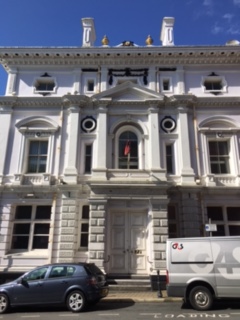
Laxey is a village on the east coast of the Isle of Man. Its name derives from the Old Norse Laxa meaning 'Salmon River'. Its key distinguishing features are its three working vintage railways and the largest working waterwheel in the world. It is also the location of King Orry's Grave.

The Manx Electric Railway is an electric interurban tramway connecting Douglas, Laxey and Ramsey in the Isle of Man. It connects with the Douglas Bay Horse Tramway at its southern terminus at Derby Castle at the northern end of the promenade in Douglas, and with the Snaefell Mountain Railway at Laxey. Many visitors take an excursion on the trams. It is the oldest electric tram line in the world whose original rolling stock is still in service.

The Snaefell Mountain Railway is an electric mountain railway on the Isle of Man in Europe. It joins the village of Laxey with the summit of Snaefell, at 2,036 feet (621 m) above sea level the highest point on the island. It connects with the Manx Electric Railway (MER) in Laxey. The line is 5 miles (8 km) long, is built to 3 ft 6 in gauge and uses a Fell Incline Railway System centre rail for braking on the steep gradients. It is electrified using overhead wires at 550 volts direct current, with bow collectors.
The pound is the currency of the Isle of Man, at parity with sterling. The Manx pound is divided into 100 pence. Notes and coins, denominated in pounds and pence, are issued by the Isle of Man Government.
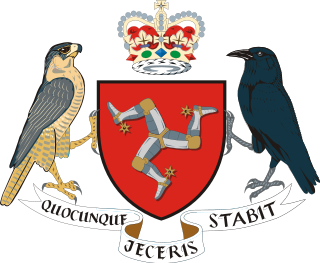
A Deemster is a judge in the Isle of Man. The High Court of Justice of the Isle of Man is presided over by a deemster or, in the case of the appeal division of that court, a deemster and the Judge of Appeal. The deemsters also promulgate the Laws on Tynwald Day by reading out brief summaries of them in English and Manx.

John Allen Mylrea MHK, was a member of the House of Keys, Chairman of the Isle of Man Steam Packet Company and a director of Dumbell's Bank, who in the late 19th century played a prominent part in the arts and culture of the Isle of Man.

Sir Alured Dumbell MLC was a senior judge who was Clerk of the Rolls of the Isle of Man.
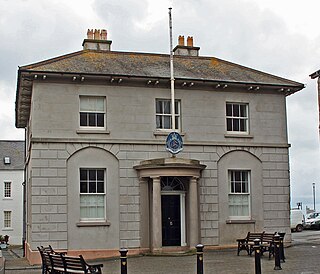
The Old House of Keys is the former meeting place of the House of Keys, the lower house of Tynwald, the Isle of Man's parliament. It is located across the street from Castle Rushen in Castletown, the former capital of the Isle of Man, in the south of the island. The building was used as the House of Keys from 1821 until 1874, when the parliament was moved to Douglas.
The Isle of Man Bank is a bank in the British Crown dependency of the Isle of Man, providing retail, private and business banking services to the local population. Incorporated in 1865, it has operated as a trading name of RBS International since 2019. It is licensed by the Isle of Man Financial Services Authority in respect of deposit taking and investment business and registered as a general insurance intermediary.
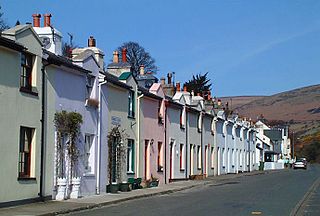
Dumbell's Row is an intermediate stopping place on the Manx Electric Railway on the Isle of Man and is the first on the northern section of the line from Laxey, opened in 1899.

The Deemster is a novel by Hall Caine published in 1887, considered to be the first 'Manx novel'. It was Caine's third novel, the second to be set in the Isle of Man and it was his first great success. The plot revolves around the reckless actions of Dan Mylrea and the exile and atonement that follow.

Sir James Gell, was a Manx lawyer, who was the First Deemster and Clerk of the Rolls in the Isle of Man. He was also the first Manxman to become Attorney General of the Isle of Man.
The Great Snaefell Mining Company was a mining company formed to operate the Great Snaefell Mine on the Isle of Man.

The Great Laxey Mine was a silver, lead ore and zinc mine located in Laxey, in the parish of Lonan, Isle of Man. The mine reached a depth in excess of 2,200 ft (670 m) and consisted primarily of three shafts: the Welsh Shaft, the Dumbell's Shaft and the Engine Shaft; each of these shafts was connected by a series of levels.
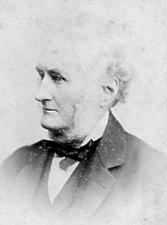
George William Dumbell QC was a British advocate, businessman and philanthropist who was invited to become a Member of the House of Keys serving two different terms. He is also remembered on the Isle of Man as being involved in two banking ventures of questionable reputation; the Joint Stock Bank and Dumbell's Bank.
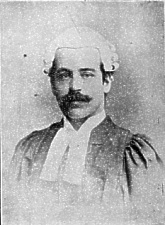
Stewart Stevenson Moore QC was a Manx lawyer, who was the First Deemster and Clerk of the Rolls on the Isle of Man.
Holmes' Bank was a bank in the British Crown dependency of the Isle of Man, providing private and business banking services to the local population. Holmes' Bank crashed spectacularly in 1853 resulting in hardship, unemployment, bankruptcy and destitution for many of the inhabitants of the Island.
Forbes Bank was a bank in the British Crown dependency of the Isle of Man, providing private and business banking services to the local population. The bank operated from 1826 until it crashed spectacularly in 1843 resulting in hardship, unemployment, bankruptcy and destitution for many of the inhabitants of the Island.
The Isle of Man and Liverpool Bank was a bank in the British Crown dependency of the Isle of Man, providing private and business banking services to the local population. The bank traded from 1836 until it was wound up in 1838.

Henry Bloom Noble JP was a Cumbrian-born philanthropist and businessman who at the time of his death was the richest resident of the Isle of Man. Noble bequeathed a large amount of his vast fortune to the people of the Isle of Man, resulting in numerous civic amenities such as recreation grounds, swimming baths, a library and a hospital.
